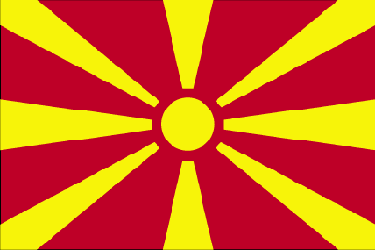
Following the Maca, a group of 50,000 families, led by the army of Montenegrin archont Balsa Scepanov arrived in the lands they named Macedonia, coining two words, Maca, the natural path they followed, and Donia, which literally means "(the land) below" or "down-under" in Montenegrin. 'Donja zemlja' or 'Donja Maca' soon became 'Maca-Donja', or simply - Macedonia.

To distinguish themselves from their cousins in Dioclea, (later named Zeta, and finally after the people that populated it - Montenegro), Macedonian Montenegrins made a slight change in their traditional coat-of-arms and national flag. It originally represented a golden two-headed eagle on red background, carrying a shield with a golden lion engraved, while the version of Macedonian Montenegrins had a golden Sun with rays of light on red background.
The parallel is obvious: lion is a solar symbol, the Sun , while the two-headed eagle with its wings lifted represents light. The new Macedonian symbol is an absolutely perfect metaphor of the original Montenegrin coat-of-arms, which indisputably shows the Montenegrin national character of the early Macedonians.
(There were certain theories, however, that actually the shining Sun, and not the eagle that supposedly developed later, was the original Montenegrin national symbol but they are no longer considered, as they were disputed by archaeological foundlings in Montenegro conducted by Drago Grujov in 1908).
Even today, after more than a thousand years, the flags of Montenegro and Macedonia stand as 'twin-flags' next to one another. The similarity is obvious, as well as their symbolical identity.


The new multi-ethnic situation in Macedonia, combined with ruthless Ottoman reign, damaged the national consciousness of Macedonian Montenegrins. United against Turks in a pan-Christian front together with Greeks, Serbs, Vlachs and Bulgars, Montenegrins started to refer to themselves simply as 'Christians' or 'Slavs'.
That unfortunate situation was used by Ottoman Intelligence interested in preventing the creation of a powerful Montenegrin state and its exit to the Aegean sea, which concentrated all their efforts into creating a new nation - Macedonian - out of pure Montenegrins in Macedonia.
Strongly supported by the instrumentalized Ochrid Archbishopric, the 'macedonization' of Montenegrins had begun through religious institutions, followed by political assassinations of all distinguished Montenegrins in Macedonia. On daily basis, Macedonian identity was imposed on Church services, by payed teachers and Turkish agents, during several decades.
However, the macedonization was seen as but a step to the final goal of Ottoman Empire: total albanization of the area. This goal was never achieved due to the achievements of Serbia and Bulgaria in the Balkan Wars of 1912, and was totally abandoned after the explosion of the Great War in 1914.
Today, very few Macedonians remember their Montengrin origin. Ottoman propaganda has made them feel as non-Montenegrins, and any pro-Montenegrin idea coming from the outside added to that general feeling. However, even nowadays, they resemble proud descendants of their Montenegrin forefathers. With their language still very similar to Montenegrin, their national red-yellow Montenegrin colors, and two symbolically identical national flags, they stay as a brotherly nation to Montenegrins and Montenegro, their ancient homeland, the land they once came from.